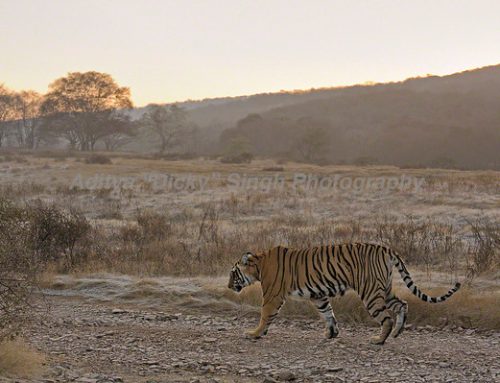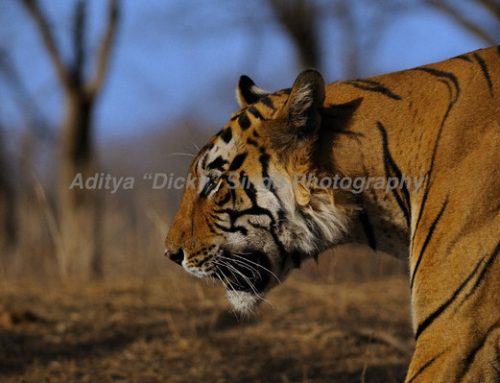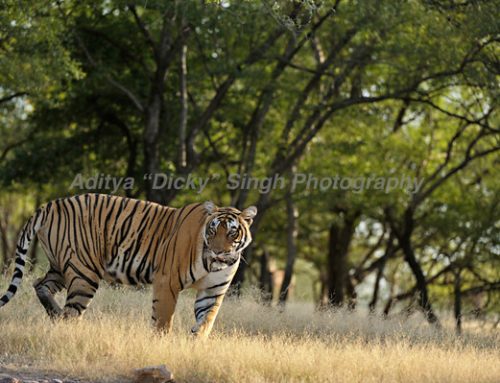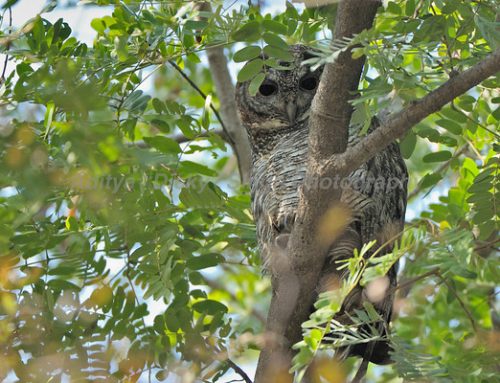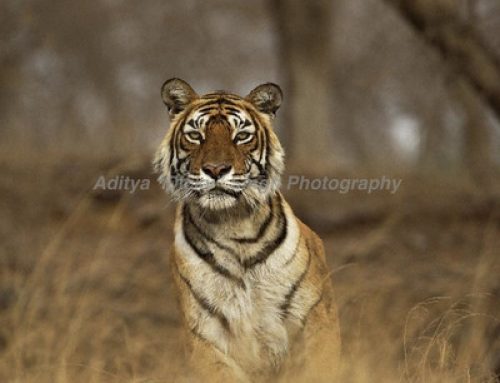The three sisters – “Satara”, “Athara” and “Unnis” (or 17, 18 and 19 in Hindi) were born during the monsoon months (July to September) of 2006. They were the three female cubs of Machali’s (T16) last litter and T 2, who was then the most dominant male of Ranthambhore, was the father. These three cubs (numbered T 17, T 18 and T 19) were first seen, fleetingly and from a distance, by a tourist vehicle in the end of October 2006, when the cubs were really small. However, it was only in December 2006 that we started seeing them regularly. I had my first great sighting of this family in early January 2007 and since then have been seeing them regularly. Right from the beginning T 17 was the dominant one of the three cubs.
When these three cubs were born, Bahadur and Sharmelee, Machali’s male and female cub from the last litter, were still living within Machali’s territory. In other words they were yet to separate from their mother. After these three cubs were born Machali became very intolerant of Sharmelee and would chase her away whenever she found her close to the younger cubs. At the same time she would tolerate Bahadur and would even let him stay in close proximity to the new cubs. Soon Sharmelee took over Lakkarda, which till them was part of Machali’s territory and would rarely cross over to the lakes, where Machali stayed with her younger cubs. Bahadur stayed with Machali and the new cubs for a few months and then drifted off to establish his territory in another part of the park.
During their initial months Machali mostly kept the cubs between the lakes and Nalghati and rarely ventured out of this area. This area has a high density of Sambar deer (India’s largest deer species) and Machali brought these cubs up largely on a diet of Sambar deer. These cubs were born about a year or two after Ranthambhore was badly hit by organized gangs of poachers and the overall tiger density had dropped in Ranthambhore. As a result this family did not have many aggressive neighbors to deal with. Soon after the cubs became slightly bigger she started taking them all over her large territory.
Right from the early days T 17 or Satara was the dominant cub of Machali’s last litter of three female cubs (T 17, T 18 and T 19). While T 17 started carving out her own territory by the end of 2007, T 18 and T 19 stayed on with their mother till the end of summers of 2008. By the end of summers of 2008, T 17 was firmly established around the lakes while T 18 had just about established a territory in the Nalghati – Phoota Banda – Phoota Kot area. T 19 had no choice but to take over the “leftovers” of Machali’s territory – the Mandoop plateau, which during the summers has very few permanent waterholes and a low prey density. Soon T 18 was relocated to Sariska and T 19 took over her territory.
T 19 was always the shyest of the three sisters and her sightings between 2008 and 2011 were few and far between. She spent most of her time in the dry streambeds in the Mandoop plateau and was rarely seen, at least compared to her sister T 17.
During the end of 2010 and beginning of 2011 she was seen mating with T 28 (or Star male), who was the dominant male of her area. A few months after this she became very elusive though evidence of her presence (mainly pugmarks and droppings) were only found in and around Nalghati area – an indication that she was either with cubs or going to deliver them soon. Soon after she was seen with three cubs – two males and one female. By the end of 2011 she expanded her already large sized territory to include the Lahpur valley – a great tiger habitat. She now rules one of the largest territories in the Ranthambhore national park and is busy training her 10 month old cubs.





